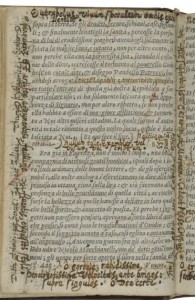Linking marginalia
Albeit with a heavy heart, due to the loss of Lisa, our director, dear friend, mentor, and source of inspiration, we’ve continuously worked on AOR. We feel it’s important to try to carry on Lisa’s legacy, which can be done partly by making AOR, a project she was so excited about and that got off the ground largely because of her vision and enthusiasm, a great success.
One of the things we’ve done is to update our website, where you now can find a download page. This page contains documentation, such as the Transcriber’s Manual, but also our very first data release, which consists of all the raw data of the project, including the XML transcriptions, the lists of people, books, and geographical locations mentioned by Harvey in his marginal notes, and accompanying documentation. Please do get back to us with any remarks, questions, and suggestions about our data!
For the remainder of this blog, though, I’d like to go back to the topic addressed in the previous blog: namely, how to link marginalia that run across different pages. As mentioned, this practice is particularly challenging for our schema, as it deliberately captures all marginal notes on one page. As a result, both parts of one marginal note are tagged as two separate marginal notes in two separate XML files. In what follows I will explain the way in which we join them together.
But first, an example of a ‘running marginal note’: in his copy of Domenichi’s Facetie, motti, et burle Harvey starts in the left margin on f. 17r with “Hic superat ipsu[m] Ca[e]sarem, et Maronem. Cedant ipse Crispus,” and he continues in the gutter of the preceding page (f. 16v) “Tacitus, Paterculus, Naso huic Eutrapelo. Quicu[m] suo Eunapio, Juliano, Philostrato [-] non modò suis Romanis,” after which the marginal note continues on to the left margin of that page with “singularis est artifex argumentosi, facillimè fluentis, exquisiti styli.”
Here is an image of this marginal note. Take into account that some parts of the text are not visible on the digital image due to the tight binding of the book, which neatly alludes to the limits of digitization, about which Matt wrote an earlier blog

The connection between the two parts of the marginal note is established via two unique IDs which are attributed to both parts. We then use an attribute to refer to the unique ID of the other part. However, we also need to establish the “direction” of a specific part: i.e., is this part the continuation of an earlier part or is it the start of the marginal note? The viewer needs to know this in order to be able to decide whether, in the digital transcription the user will be seeing, the text of a particular part needs to be put in front of or after the text of the other part to which it is linked.
So far, the XML for the parts of this marginal note would be:
marginalia marginalia_id=”Ha2.016v_0001″ marginalia_continues_from=”Ha2.017r_0001″
marginalia marginalia_id=”Ha2.017r_0001″ marginalia_continues_to=”Ha2.016v_0001″
We’re still not there yet, as we also need to provide information about the book (in case Harvey continues a marginal note in another book, which can happen, at least in theory, when two books are bound together) as well as about the XML file in which the other part of the marginalia is captured. This information is supplied in two attributes: book_id and marginalia_from/to_transcription (note that this attribute also contains the “direction” of the marginal note). All of which makes:
marginalia marginalia_id=”Ha2.016v_0001″ marginalia_continues_from=”Ha2.017r_0001″ book_id=”FolgersHa2″ marginalia_from_transcription=”Ha2.017r.xml”
marginalia marginalia_id=”Ha2.017r_0001″ marginalia_continues_to=”Ha2.016v_0001″ book_id=”FolgersHa2″ marginalia_to_transcription=”Ha2.016v.xml”
Admittedly, the names of some attributes are a bit clunky, yet this nevertheless is quite a straightforward solution, even though transcribers have to be careful not to mix up the IDs and the “direction” of the marginal notes (read this as a note to myself, as I’ll be modifying the relevant XML files). For me, this was a particularly interesting challenge to deal with, especially because it again brought together the scholarly and technical strands of this project as it involved discussions with Matt here at the CELL HQ and with Mark and John, the “techies” at DRCC. As a result, this solution is very much the outcome of an incremental process, resembling the development of the XML schema as a whole. The issue of linking marginalia, as it touches upon various aspects of this project, again highlights why DH projects, and AOR in particular, are so fascinating.
